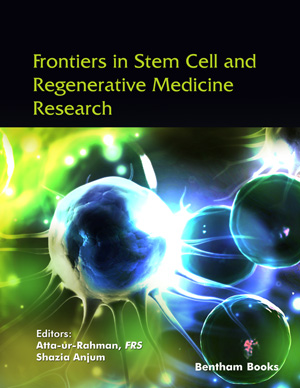
Abstract
Stem cell therapy is widely regarded as a promising strategy in regenerative medicine, yet the therapeutic effects of stem cells in vivo are limited by many factors when applied without additional factors, such as poor cell engraftment, uncontrolled differentiation, and unclear cell fates and niches. The emergence of nanotechnology has provided several solutions for these problems. Nanomaterial-based cell labeling and tracking have been extensively investigated in recent decades, and many innovative and multifunctional nanomaterials have been used to reveal the fate of stem cells, allowing more efficient, sensitive, and accurate imaging/tracking strategies for stem cells to be achieved. Nanomaterials enhance stem cell therapy by incorporating or integrating with stem cells and, as scaffolds or substrates, nanomaterials with antioxidant properties that can be used as graft coatings show great promise for clinical transformation. However, current reviews on the subject tend to focus on the various effects of nanomaterials on stem cells and are less concerned with their application to stem cell therapy. Accordingly, we herein present a review of progress in the application of nanomaterials in stem cell therapy over the last three years, which we hope will be of benefit to a comprehensive understanding of nanomaterial-mediated stem cell therapy from lab to pre-clinical practice.
Keywords: nanomaterials, cell imaging, drug delivery, stem cell therapy, regenerative medicine, therapeutic effects
[http://dx.doi.org/10.1016/S0092-8674(04)00208-9] [PMID: 15006347]
[http://dx.doi.org/10.1016/j.stem.2015.09.003] [PMID: 26431181]
[http://dx.doi.org/10.1007/s12265-016-9708-y] [PMID: 27542008]
[http://dx.doi.org/10.1002/stem.584] [PMID: 21732485]
[http://dx.doi.org/10.1016/j.jconrel.2017.07.023] [PMID: 28736264]
[http://dx.doi.org/10.1038/aps.2013.50] [PMID: 23736003]
[http://dx.doi.org/10.1002/jcb.26169] [PMID: 28543595]
[http://dx.doi.org/10.1016/j.scr.2015.02.003] [PMID: 25752437]
[http://dx.doi.org/10.1159/000492704] [PMID: 30121644]
[http://dx.doi.org/10.1016/j.molmed.2013.03.001] [PMID: 23537753]
[http://dx.doi.org/10.1186/s13287-017-0567-5] [PMID: 28494803]
[http://dx.doi.org/10.1016/j.stem.2015.06.007] [PMID: 26140604]
[http://dx.doi.org/10.1098/rstb.2011.0334] [PMID: 23166396]
[http://dx.doi.org/10.1038/nm.3267] [PMID: 23921754]
[http://dx.doi.org/10.1038/nrd.2016.245] [PMID: 27980341]
[http://dx.doi.org/10.1016/j.semcdb.2019.01.005] [PMID: 30639325]
[http://dx.doi.org/10.1126/science.1171643] [PMID: 19556500]
[http://dx.doi.org/10.1002/adhm.201500272] [PMID: 26010739]
[http://dx.doi.org/10.1002/smll.201000528] [PMID: 20602428]
[http://dx.doi.org/10.1016/j.biotechadv.2012.08.001] [PMID: 22902273]
[http://dx.doi.org/10.1186/s13287-016-0440-y] [PMID: 28038681]
[http://dx.doi.org/10.1039/c3cs35486e] [PMID: 23740388]
[http://dx.doi.org/10.1039/C8CS00457A] [PMID: 30534770]
[http://dx.doi.org/10.1039/C8RA02424C]
[http://dx.doi.org/10.1016/j.stem.2009.04.011] [PMID: 19427289]
[http://dx.doi.org/10.1038/nature04960] [PMID: 16810245]
[http://dx.doi.org/10.1038/nbt1327] [PMID: 17721512]
[http://dx.doi.org/10.1038/nrclinonc.2011.141] [PMID: 21946842]
[http://dx.doi.org/10.2217/17435889.3.4.567] [PMID: 18694318]
[http://dx.doi.org/10.1021/ja1084095] [PMID: 21314118]
[http://dx.doi.org/10.1021/acs.nanolett.7b02106] [PMID: 28654292]
[http://dx.doi.org/10.1039/C7MH00672A]
[http://dx.doi.org/10.1038/s41467-018-03505-4] [PMID: 29563581]
[http://dx.doi.org/10.1021/acsnano.8b05906] [PMID: 30433761]
[http://dx.doi.org/10.1021/acsnano.9b01802] [PMID: 31250647]
[http://dx.doi.org/10.1002/jcp.20408] [PMID: 15887245]
[http://dx.doi.org/10.18632/oncotarget.11070] [PMID: 29029404]
[http://dx.doi.org/10.1002/smll.201702679] [PMID: 29171718]
[http://dx.doi.org/10.1016/j.stem.2014.03.009] [PMID: 24702995]
[http://dx.doi.org/10.1021/acsnano.9b02173] [PMID: 31584257]
[http://dx.doi.org/10.1038/nature03808] [PMID: 15988521]
[http://dx.doi.org/10.1021/acs.nanolett.6b04865] [PMID: 28206771]
[http://dx.doi.org/10.1038/s41467-019-09704-x] [PMID: 31028253]
[http://dx.doi.org/10.1021/acs.jpclett.5b00610] [PMID: 26266727]
[http://dx.doi.org/10.1021/acsnano.9b08660] [PMID: 31999433]
[http://dx.doi.org/10.1039/C2CS35265F] [PMID: 23238558]
[http://dx.doi.org/10.1039/C4NR06377E] [PMID: 25619169]
[http://dx.doi.org/10.1016/j.actbio.2013.07.030] [PMID: 23917148]
[http://dx.doi.org/10.1016/j.bone.2008.06.019] [PMID: 18675385]
[http://dx.doi.org/10.1016/j.actbio.2015.12.006] [PMID: 26689464]
[http://dx.doi.org/10.1021/acsbiomaterials.7b00506] [PMID: 33418690]
[http://dx.doi.org/10.1371/journal.pone.0116462] [PMID: 25659106]
[http://dx.doi.org/10.1016/j.actbio.2019.07.008] [PMID: 31284095]
[http://dx.doi.org/10.1002/smll.201502119] [PMID: 26780591]
[http://dx.doi.org/10.2147/IJN.S182428] [PMID: 30538454]
[http://dx.doi.org/10.1021/acsnano.8b06032] [PMID: 31184474]
[http://dx.doi.org/10.1016/S0074-7696(07)57001-4] [PMID: 17280894]
[http://dx.doi.org/10.1038/nbt.4162] [PMID: 29969440]
[http://dx.doi.org/10.1016/j.stem.2019.07.010] [PMID: 31491395]
[http://dx.doi.org/10.1016/j.ejheart.2008.03.017] [PMID: 18436478]
[http://dx.doi.org/10.1002/stem.1265] [PMID: 23081858]
[http://dx.doi.org/10.1002/stem.2777] [PMID: 29327399]
[http://dx.doi.org/10.1002/sctm.18-0244] [PMID: 31157513]
[http://dx.doi.org/10.1038/gt.2008.41] [PMID: 18369324]
[http://dx.doi.org/10.1002/stem.313] [PMID: 20127797]
[http://dx.doi.org/10.1038/cdd.2014.81] [PMID: 24948009]
[http://dx.doi.org/10.1021/acs.nanolett.8b04697] [PMID: 30773888]
[http://dx.doi.org/10.1039/C4NR05791K] [PMID: 25652717]
[http://dx.doi.org/10.1182/blood-2002-06-1830] [PMID: 12480709]
[http://dx.doi.org/10.1021/acs.nanolett.7b04089] [PMID: 29393650]
[http://dx.doi.org/10.2147/IJN.S204910] [PMID: 31308662]
[http://dx.doi.org/10.2217/nnm.14.225] [PMID: 25816883]
[http://dx.doi.org/10.1155/2016/1513285] [PMID: 26880934]
[http://dx.doi.org/10.1016/j.yexcr.2007.02.031] [PMID: 17428465]
[PMID: 30368818]
[http://dx.doi.org/10.1021/cr300426x] [PMID: 23391258]
[http://dx.doi.org/10.1038/nmat4051] [PMID: 25108614]
[http://dx.doi.org/10.1016/j.biomaterials.2018.01.034] [PMID: 29421547]
[http://dx.doi.org/10.1039/C9NR03424B] [PMID: 31651003]
[http://dx.doi.org/10.1016/j.biomaterials.2019.119650] [PMID: 31806404]
[http://dx.doi.org/10.1021/acsnano.8b03865] [PMID: 30178996]
[http://dx.doi.org/10.3389/fcell.2017.00051] [PMID: 28540289]
[http://dx.doi.org/10.1038/nrneurol.2017.45] [PMID: 28418023]
[http://dx.doi.org/10.1038/s41586-018-0068-4] [PMID: 29769671]
[http://dx.doi.org/10.1038/sj.sc.3101674] [PMID: 15520836]
[http://dx.doi.org/10.1021/acsnano.9b07598] [PMID: 31769966]
[http://dx.doi.org/10.1021/acsnano.9b04109] [PMID: 31518110]
[http://dx.doi.org/10.1186/1556-276X-7-309] [PMID: 22709686]
[http://dx.doi.org/10.1161/CIRCRESAHA.109.212589] [PMID: 20378859]
[http://dx.doi.org/10.1021/ja104683w] [PMID: 21141957]
[http://dx.doi.org/10.2217/rme.15.36] [PMID: 26390317]
[http://dx.doi.org/10.1210/en.2009-1082] [PMID: 20016026]
[http://dx.doi.org/10.3727/096368911X627381] [PMID: 22405128]
[http://dx.doi.org/10.1073/pnas.1816792116] [PMID: 30760598]
[http://dx.doi.org/10.1021/acsnano.9b08061] [PMID: 31880428]
[http://dx.doi.org/10.1016/j.cell.2004.10.017] [PMID: 15537542]
[http://dx.doi.org/10.1289/ehp.1002337] [PMID: 20840908]
[http://dx.doi.org/10.1016/j.reprotox.2017.01.005] [PMID: 28088501]
[http://dx.doi.org/10.1016/j.actbio.2019.05.042] [PMID: 31125729]
[http://dx.doi.org/10.1021/acsnano.8b08604] [PMID: 30650303]
[http://dx.doi.org/10.1080/17435390.2020.1755470] [PMID: 32401081]












